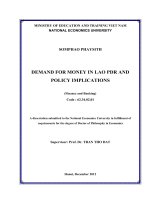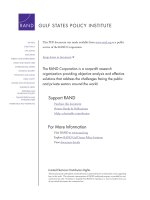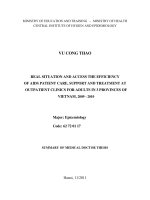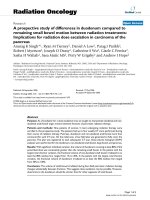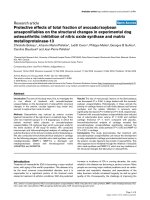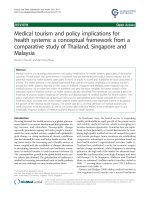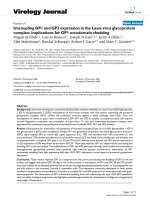REGIONAL INTRA TOURISM MARKET IN ASEAN AFTER THE ESTABLISHMENT OF THE AEC: PERSPECTIVES AND POLICY IMPLICATIONS FOR VIETNAM
Bạn đang xem bản rút gọn của tài liệu. Xem và tải ngay bản đầy đủ của tài liệu tại đây (851.62 KB, 92 trang )
FOREIGN TRADE UNIVERISTY
FACULTY OF ECONOMICS AND INTERNATIONAL BUSINESS
---------***-------
GRADUATION THESIS
Major: International Business Economics
REGIONAL INTRA TOURISM MARKET IN ASEAN
AFTER THE ESTABLISHMENT OF THE AEC:
PERSPECTIVES AND POLICY IMPLICATIONS
FOR VIETNAM
Student full name
: Trinh Thi Minh Huong
Student ID
: 1112150060
Class
: A28 – High Quality Program
Cohort
: 50
Supervisor
: Do Ngoc Kien, MPP.
Hanoi, May 2015
TABLE OF CONTENTS
LIST OF ABBREVIATIONS........................................................................................i
LIST OF FIGURES......................................................................................................ii
LIST OF TABLES.......................................................................................................iii
INTRODUCTION........................................................................................................1
CHAPTER 1: THEORETICAL BACKGROUND ABOUT REGIONAL
INTRA TOURISM.......................................................................................................5
1.1.
Basic concepts related to regional tourism market............................................5
1.1.1.
Definitions of tourism.................................................................................5
1.1.2.
Definitions of regional tourism..................................................................7
1.1.3.
Definition of regional tourism market........................................................7
1.1.4.
Definitions and classifications of tourists..................................................8
1.2.
Demand tourism in theoretical aspects..............................................................8
1.2.1.
Demand tourism in Maslow theory............................................................8
1.2.2.
Gravity framework...................................................................................10
1.3.
Determinants to build up regional intra tourism market..................................11
1.3.1.
Demand of regional tourism market.........................................................11
1.3.2.
Supply of regional tourism market...........................................................12
1.4.
Factors affecting to regional tourism market...................................................12
1.4.1.
Factors affecting to supply of regional tourism market............................12
1.4.2.
Factors affecting to demand of regional tourism market..........................17
1.5. The impacts of regional economic integration on the intra – regional
tourism......................................................................................................................18
1.5.1.
Levels of regional economic integration..................................................18
1.5.2. Influences of regional economic integration on the intra – regional
tourism 21
1.6.
Experiences of developing regional intra tourism market...............................24
CHAPTER 2: STATUS QUO AND PERSPECTIVES OF ASEAN’S INTRA –
REGIONAL TOURISM MARKET IN THE CONTEXT OF THE AEC
ESTABLISHMENT....................................................................................................27
2.1.
Overview about the AEC.................................................................................27
2.1.1.
Background about the AEC......................................................................27
2.1.2.
Characteristics and goals of the AEC......................................................27
2.2. Reasons considering regional tourism as a priority compared with other
kinds of tourism........................................................................................................30
2.2.1.
Growth of GDP and economic similarity of AMS.....................................30
2.2.2.
Cultures of nations in ASEAN.................................................................33
2.3. Situation of regional tourism market in ASEAN before the AEC
establishment.............................................................................................................33
2.3.1.
The size of regional intra tourism in ASEAN............................................33
2.3.2.
Situation of intra – ASEAN tourist arrivals in each AMS.........................39
2.4.
Prospects of ASEAN regional tourism after establishing the AEC..................43
2.4.1.
Strengths and weaknesses to develop regional intra tourism in ASEAN
43
2.4.2.
AEC
Opportunities for regional intra tourism in ASEAN after forming the
.................................................................................................................45
2.4.3.
Challenges for intra – ASEAN tourism after the AEC establishment.......49
CHAPTER 3: POLICY IMPLICATIONS FOR VIET NAM IN THE
CONTEXT OF ESTABLISHING THE AEC...........................................................52
3.1.
Situation of intra – ASEAN tourist arrivals to Vietnam...................................52
3.2. Orientation of developing Vietnamese tourism in the context of forming the
AEC ........................................................................................................................54
3.2.1.
Orientation for developing tourism markets.............................................54
3.2.2.
Orientation to develop tourism products..................................................57
3.2.3.
Orientation towards supply source of tourism service..............................58
3.3. Recommendations for developing Vietnamese regional tourism market
while establishing the AEC.......................................................................................60
3.3.1.
Recommendations for legal framework....................................................60
3.3.2.
Recommendations for infrastructure........................................................62
3.3.3.
Recommendations for human resource in tourism sector.........................68
CONCLUSION...........................................................................................................73
REFERENCES...........................................................................................................75
APPENDICES............................................................................................................83
5
LIST OF ABBREVIATIONS
No.
1
2
3
4
5
6
7
8
9
10
11
12
13
14
15
Abbreviations
AEC
AMS
ASEAN
ATSP
CLMV
CM
CU
EUR
FTA
GDP
ICT
LDCs
MICE
MRA
OECD
16
17
18
19
20
21
22
23
24
R&D
SMEs
TOTAL
UNWTO
USD
VND
WEF
WTO
WTTC
Full name
ASEAN Economic Community
ASEAN Member States
Association of South East Asia Nations
ASEAN Tourism Strategic Plan
Cambodia, Lao PDR, Myanmar, and Viet Nam
Common Market
Common Union
Euro
Free Trade Area
Gross Domestic Product
Information and Communication Technology
Least Developed Countries
Meeting, Incentive, Convention, Exhibition
Mutual Recognition Arrangement
The Organization for Economic Co-operation and
development
Research and Development
Small and Medium Enterprises
Tourism Talent Plan
United Nations World Tourism Organization
United States Dollars
Viet Nam Dong
World Economic Forum
World Tourism Organization
World Travel & Tourism Council
6
LIST OF FIGURES
Figure 1.1:
Figure 1.2:
Figure 1.3:
PAGE
Maslow’s hierarchy of people needs
9
Gravity model in international tourism flows
11
Creation effect of regional economic integration on regional
22
Figure 1.4:
tourism
Average expenditure per inbound trip by residents from
25
Figure 2.1:
Figure 2.2:
Figure 2.3:
Figure 2.4:
Figure 2.5:
other EU-28(*), 2012
Strategic directions and actions of ASEANs
Share in global GDP of from 2008 to 2012 ASEAN
Percentage of intra - ASEAN trade - in services in 2013
Structure of ASEAN tourist arrivals from 2009 to 2013
Share of intra – ASEAN tourist arrivals by host country in
29
32
34
35
41
Figure 2.6:
Figure 2.7:
2013
Proportion of visa required to visit ASEAN countries in 2013
Proportion of tourists based on means of transportation in
43
45
Figure 2.8:
Figure 2.9:
2012
Employment by sector of some AMS
Airport numbers in ASEAN countries between 2008 and
46
48
Figure2.10:
2012
Growth rate of Domestic air passenger traffic per thousand
50
Figure 3.1:
Figure 3.2:
persons
Hotel performance of big cities of ASEAN countries
Internet users per 100 people in Vietnam from 2008 to 2013
64
68
7
LIST OF TABLES
Table 1.1:
Table 1.2:
Table 2.1:
Table 2.2:
Table 2.3:
Table 2.4:
ICT needs to tourism
Levels of regional economic integration and its characteristics
GDP and GDP forecast of AMS from 2010 to 2016
Proportion of ASEAN tourist arrivals from 2008 to 2013
Performance of AMS regulatory framework
Intra – ASEAN visitor arrivals by country of destinations from
PAGE
16
20
31
37
38
40
Table 2.5:
Table 3.1:
Table 3.2:
2009 to 2013
Ranking of doing and starting business in ASEAN countries
Performance of AMS in TTCI 2011
Intra – ASEAN tourism arrivals to Vietnam in the first three
50
52
53
Table 3.3:
Table 3.4:
months of 2015
Level of priority to develop regional tourism market in Vietnam
Forecast for the criteria to develop Vietnam tourism in the
55
56
Table 3.5:
period 2015 and 2020
Investment capital for tourism sector in Vietnam between 2011
59
and 2020
Table 3.6:
Table 3.7:
Top 10 biggest hotel corporation in the world in 2014
Performance of Human Resource of some AMS in 2012
65
69
1
INTRODUCTION
1. Rationale
Tourism industry has expanded and diversified quickly. This kind of service
stands among one of the most rapidly developing industries all over the world and
greatly contributes to the whole economy GDP. According to World Travel &
Tourism Council (WTTC) (2014), total contribution of travel and tourism to GDP
was more than 7000 billion USD in the year of 2013 (around 9.8% of the whole
economy GDP). More importantly, international tourism makes up for 29% of the
world’s exports of services and also 6% of overall exports of goods and services.
Furthermore, the tourism sector can be considered as key driver of growth and
leading role in solving employment. WTTC (2014) has also pointed out that travel
and tourism had created 100,894,000 jobs in 2013 which accounted for 3.4% of
total employment. This includes employers working in hotels, travel agents, airlines
and so on. It is estimated that tourism will generate more than 126 million jobs – a
rise of 2% per annum over the next ten years. These all above data demonstrate the
essentiality of the tourism industry in the economy.
ASEAN tourism market is one of the most dynamic markets all over the
world and has greatly contributed to the economical growth in this region. Most of
the countries in ASEAN have paid attention to develop tourism and some of them
are becoming the most favorite tourist attractions such as Thailand, Singapore and
so on. In the year of 2013, the total number of visitors travelling to ASEAN was
more than 98 million – a rise of more than 9.8% compared with 2012 (ASEAN,
2015a). Specifically, intra – ASEAN tourism (tourists from ASEAN countries
visiting other ASEAN countries) account for 43% of all international tourists
arrivals in ASEAN (World Economic Forum (WEF), 2012). From this figure, we
can see that regional intra tourism in ASEAN makes up for nearly half of the total
proportion of ASEAN tourists’ arrivals.
In the context of regionalization, ASEAN has decided to build up the
ASEAN Economic Community (AEC) in the end of the year 2015. The final
purpose of AEC is to increase the competitive ability of ASEAN, fully improve the
2
ASEAN economy in the world. Undoubtedly, the AEC will open up more
opportunities for all the economic sectors in general and tourism in particular as
well as creates burdens for members in ASEAN. From the point of establishing
AEC, there would be changes in regional tourism market in ASEAN and in Vietnam
in particular.
For all the reasons above, my topic “Regional intra tourism market in
ASEAN after the establishment of the AEC: Perspectives and policy implications
for Vietnam” was officially launched to research. This study is conducted in order
to bring an overall picture of regional tourism market in ASEAN since the AEC is
established and make some recommendations for Vietnam of how to adapt with a
new context – establishment of the AEC
2. Research objectives
This thesis attempts to observe the regional intra tourism market in ASEAN
before and after the establishment of the AEC so as to suggest effective policy for
attracting visitors to Vietnam in the case of establishing the AEC.
The following questions will be answered:
Why is regional tourism more important than other kinds of tourism in
ASEAN?
How is the status quo of regional tourism market in ASEAN before forming
the AEC?
How will ASEAN regional intra tourism market be after establishing the
AEC?
What are the benefits as well as challenges that AEC brings to Vietnam
regional tourism market?
What can be implemented to develop tourism in Vietnam in the context of
establishing the AEC?
3. Research methods
My research is conducted by a number of methods namely comparison,
description, interpretation, synthesis. Data and information are mostly obtained
3
from the empirical studies of prior researchers, statistics and materials from existing
reports as well as prestigious websites.
4. Scope of the thesis
My graduation thesis will focus on the following points:
Observing the regional intra tourism in ASEAN in previous years
Studying the AEC and its role in boosting regional tourism, perspectives that
regional tourism in ASEAN will be after establishing the AEC
Examining the current tourism situation in Vietnam in terms of policy, the
numbers of intra – ASEAN visitors coming to Vietnam
Give some policy implications for Vietnamese tourism in order to adapt with
new context when forming the AEC
5. Structure of the thesis
My thesis is divided into three chapters as following:
Chapter 1 commences with the theoretical background of regional intra
tourism by providing a variety of definitions and concepts related to tourism. Some
theoretical models as well as determinants to build up regional tourism market will
also be mentioned. The other part of chapter 1 brings an overview of the impacts of
regional economic integration to regional tourism market. In the final part of the
first chapter, experiences from some countries which successfully develop regional
intra tourism market in the context of regional economic integration will be
introduced.
Chapter 2 firstly presents the background about the AEC by introducing in
detail its characteristics which are considered to be greatly affected to regional
tourism market. The next part covers the situation of regional intra tourism market
in ASEAN before the AEC establishment. Then perspectives of regional intra
tourism market in ASEAN after forming the AEC are analyzed accordingly.
Chapter 3 studies the situation of intra – ASEAN tourists to Vietnam as well
as the status quo of tourism infrastructure, human resource. After that, orientations
to develop Vietnam tourism to attract intra – ASEAN tourists in the context of
forming the AEC will be mentioned. From that, some policies will be given for
4
Vietnam tourism market so that we can adapt with new situation that the AEC will
bring to economy in general and tourism in particular.
Upon completion of this thesis, I would like to express my great thanks to
my supervisor - Do Ngoc Kien, MPP. for his insightful guidance and continuous
support. He has not only oriented topic for me so that it can match with current
situation and my ability but also given me thorough comments for my research from
the start. Without his encouragement, my thesis would be hardly finished.
5
CHAPTER 1: THEORETICAL BACKGROUND ABOUT
REGIONAL INTRA TOURISM
1.1.
Basic concepts related to regional tourism market
1.1.1. Definitions of tourism
Before entering to know the meanings of regional intra tourism, it is essential
to have some basic understandings about tourism. The definitions of tourism can be
understood in many ways and different aspects. To narrow it down, this research
focuses on the concepts of the most popular organization regarding tourism.
According to United Nations World Tourism Organization (UNWTO)
(2014a), tourism is a phenomenon. It is defined as “a social, cultural and
economic phenomenon which entails the movement of people to countries or places
outside their usual environment for personal or business/professional purposes.” In
the first concept, we see criteria to characterize a travel belonging to tourism.
Displacement “outside their usual environment”, it means it can be
international travel or domestic ones
Purpose: tourism can be occurred for personal purpose such as recreation,
visiting friends and family or relaxing or business ones (people who work in
a different place compared with their usual address)
In other definition, “Tourism comprises the activities of persons travelling to
and staying in places outside their usual environment for not more than one
consecutive year for leisure, business and other purposes not related to the exercise
of an activity remunerated from within the place visited.” (WTO, 2008). Under this
concept, the travel must occur for any purpose rather than earning money in the
place visited. And, this can be understood that tourism can be enhanced to
entertainment or recreation for people. Furthermore, the duration or maximum
length of tourism is 12 hours. Base on this concept, the subject matters of tourism
include:
Tourist: person who desires to travel decides destinations and activities to
join in one trip.
6
Business firms: they provide goods and services for tourism. Tourism creates
chances for them to gain profit by meeting the demand of visitors.
Local authorities: they are the leader of destinations who recognize the
positive factors for economics of that region by income from tourism.
Local residences: they consider tourism as important elements to create jobs
and exchange culture. However, tourism causes negative effects to local
residences such as destroying environment, disordering security.
Finally, based on the Vietnamese Law of Tourism in 2005 article 4, “tourism
means activities connected with trips taken by people outside their habitual
residences aimed at satisfying their needs for sightseeing, study, leisure or
recreation in certain period of time”.
In this thesis, tourism is defined as the synthesis of phenomena and
relationships arising from interactions among tourists, business firms, local
authorities and residences in the process of attracting and welcoming tourists
So views of tourism have supplemented together, but they are still based on
describing phenomenon sticking with tourists. And from the above definitions, we
also see nature of tourism – a form of service. Because of that, it appears characters
of services, which are
Intangible: Tourism is not a kind of goods, but it stands among different
kinds of services. If consumers have the chance to see, touch, hear or smell
the goods before buying them, they cannot apply it to tourism. They just
evaluate whether they are satisfied from tourism services such as hotel,
transportation or not.
Inseparability: Tourism is generally created or supplied simultaneously. It
cannot be separated with other supporting services. Tourism services and
their providers are associated closely and thus, not separable. For example,
when we travel, we need to find air tickets in case of long distance between
two countries. So the appearance of tourists must go together with air agency.
Heterogeneous: This character of services makes it tough to line a
customary for any service. No doubt, different service suppliers will have
different quality. And the perception of people at the extent of suppliers and
7
consumers is also distinct. More importantly, each of people will evaluate
tourism service differently based on their satisfactions and feelings. For
instance, the tourism quality in Thailand is different from that in Vietnam.
Some tourists like coming to Thailand as it has many golden temples, on the
other hand, some visitors love Vietnam more than Thailand as they feel more
safety to stay in Vietnam. Because of that, it is quite hard to draw a standard
for tourism services. In terms of consumers, because of different needs,
suppliers have to adjust their services.
Seasonal: Of course, the consumption of tourism service will reach a peak in
some times. Take Vietnam as a good example. From May to July every
month, the number of travelers is relatively higher than other months. The
reason is that the former months is holiday for students. Moreover, the
weather climate in these months is also suitable for travelling.
1.1.2. Definitions of regional tourism
Undoubtedly, regional intra tourism is one kind of tourism so it should be
contained some basic characteristics of tourism, which are:
Purpose: serving people in terms of entertainment, recreation or other
business purpose but not serving for earning money.
Duration: A trip will not be extended for more than one consecutive year.
Furthermore, region refers to the countries within the geographical area
classified by WTO which are Africa, America, Europe, East Asia and Pacific
Region, Middle East and South Asia (Agarwal & Jpadhyay, 2006, p.19)
By these above points, regional intra tourism can be understood as tourist
flow to and from countries for not more than one consecutive year in the same
region of the global for leisure, business and other purposes in the member
countries visited.
1.1.3. Definition of regional tourism market
In a narrow sense, market is a medium that allows buyers and sellers of a
specific goods or services to interact to facilitate an exchange. In economic sense,
market is the interaction between supply and demand of goods and services. In
8
other words, it is the place for people with the desire and ability to buy or use a
specific products and services.
From the above understanding about market, regional tourism market can be
understood as a medium where selling and buying transaction happen as well as the
meeting point of supply and demand tourism. More importantly, the transaction
must happen in a particular economic region such as ASEAN, Europe, and so on.
1.1.4. Definitions and classifications of tourists
According to UNWTO (2008), tourists are who “traveling to and staying in
places outside their usual environment for not more than one consecutive year for
leisure, business and other purposes” and they can be:
International tourists: they can be inbound tourists (people who come from
another country travel to one country) or outbound tourists (people who
currently stay in one country travel to a foreign country)
Internal tourists: they are citizens and foreigners who currently stay in one
country travel to different destinations in that country.
Domestic tourists: include internal tourists and inbound tourists.
National tourists: include internal tourists and outbound tourists
Base on United Nations Statistical Commission (2008) a tourist is “a
traveler taking a trip to a main destination outside his/her usual environment, for
less than a year, for any main purpose (business, leisure or other personal purpose)
other than to be employed by a resident entity in the country or place visited”.
1.2.
Demand tourism in theoretical aspects
1.2.1. Demand tourism in Maslow theory
Maslow had given model generalizing people needs arranged by the
following order which illustrated in the figure 1.1. From the Maslow model, low
level needs such as physiological requirements and safety must be satisfied before
higher level needs such as knowledge and understanding, self-actualization are
pursue.
9
Figure 1.1: Maslow’s hierarchy of people needs
S
e l f a c t u a l i z a t i o n
K
n o w
l e d g e
a n d
u n d e r s t a n d i n g
A
B
e
S
P
a
h
l o
n
f e
y
g
e
s t h
e
t i c
E
s t e
e
m
i n
t y
a
s i o
l o
g
n
g
a
d
n
d
s e
i c
a
s
l
l o
c
u
n
v
e
r i t y
e
e
d
s
Source: Maslow & Stephens (2000)
The first level is physiological needs which are those required to sustain life
such as food, water. People will find this as the most important needs as they
require them to survive. Once physiological needs are met, people’s attention turns
to safety and security so that they can avoid threats.
When a person has met the lower level, higher needs become important. The
first of which are belonging and love. This means people need to interact with
others. After a person feels a sense of “belonging”, the need to feel important arises.
And they will find to aesthetics and knowledge needs. Nguyen Van Dinh & Tran
Thi Minh Hoa (2006) raised the view that when the economic growth is increasing,
people needs will be not only physiological ones but also aesthetics, entertainment
and tourism stands among many methods to meet these above mentioned needs. At
that point, people find tourism as a way for them to explore new things, enhance
knowledge.
In a nutshell, people always tend to satisfy the higher level needs when they
are fully met the lower level. Moreover, the growth of people budget, of course, will
make them find a way to satisfy the higher level. To some extent, the Maslow’s
hierarchy of people needs has viewed the demand of tourism where persons will
10
find tourism as a way to satisfy their needs of enhancing knowledge, understanding
aesthetics.
1.2.2. Gravity framework
The Newton law of gravitation states that two celestial bodies are subjected
to a force of attraction that is directly proportional to their mass and indirectly
proportional to their distance (Balali, 2007). Subsequently, the so – called “gravity
model” has widely used in the economics to international trade flows.
Tourism is a kind of service and its trade, for that reason, can be evaluated by
gravity model. Below here is model that affects to the level of tourism flows in a
region. Complied and amended from the gravity model for international trade of Tu
Thuy Anh & Dao Nguyen Thang (2008), author constructed gravity model for
international tourism flow as specified in the figure 1.2.
Based on the figure 1.2 which illustrates the gravity model in international
tourism flow, there are hinder as well as attracting factors that have influence to
tourism flows between nations in the same region. From the figure, distance factor
in gravity model has influence to tourism flows between two countries. Moreover,
there are attracted and hinder factors which have influence to intra regional tourism
flows among countries in the same region namely tourism policy, infrastructure and
human resource of countries in the same region.
Balali (2007) had researched the factors affecting to tourism flows between
two countries by using gravity model with three explanatory namely economic
growth measured by GDP, population of two countries and geographical distance.
He concluded that the tourist arrivals between two countries were assumed to
increase along with GDP, decrease with the cost of transportation as measured by
the distance between two countries. No doubt, the higher cost of transportation will
make tourists become less willing to travel and vice versa. Another one is
government policy which also has potential impacts to tourism flows. It can
encourage or on the other hand, discourage tourists to travel to another country.
11
Figure 1.2: Gravity model in international tourism flow
Push
Pull
Country A
Tourism
Policy,
Infrastructure,
Human Resource
of country A
Country B
Destination
Tourism
Policy,
Infrastructure,
Human Resource
of country B
Distance between 2
countries
Attracted/ Hinders factors
affecting to supply
-
Attracted/ Hinders factors
affecting to demand
Factor affects to regional tourism flows
Source: Constructed by author based on gravity model in international trade of Tu
Thuy Anh & Dao Nguyen Thang (2008)
Another one is government policy which also has potential impacts to
tourism flows. It can encourage or on the other hand, discourage tourists to travel to
another country. Likewise, infrastructure and human resource of both countries will
have great impacts to regional tourism flows, which will be explained in detail in
the latter part.
1.3.
Determinants to build up regional intra tourism market
1.3.1. Demand of regional tourism market
As illustrated in the above part, when the sustainable needs such as foods,
drinks are satisfied, people will find to higher level such as explore the world, relax
after hard – working hours. Demand of regional tourism market is the quantity of
tourism services that tourists live in the same region can use and have ability to
12
make payment. The higher the price for tourism services is, the lower level of
demand curve is.
Do Huong Lan et al. (2013) regarded that the demand of regional tourism
service includes three main types. The first one is “sustainable demand”. It is
demand of tourists to travel, to eat and relax during their trips. The second is
“particular demand” which indicates the tourists’ purposes during their trips such as
visiting purpose, studying purpose and so on. The final one is “supplemented
demand” which is not listed out before their trip. In other words, it arises out of
tourist’ purpose such as shopping.
1.3.2. Supply of regional tourism market
In a narrow sense, supply of regional tourism market is the ability to provide
services for tourists’ trips. The supply of regional tourism market is performed by
Selling tours agents: They can sell tours directly to tourists or indirectly to
other tourism company. Normally, they will have a long relationship with
tourism companies so that they can have a good source of buyers. Nowadays,
tour agents will issue full package tickets to tourists which include tour
guides, transportation, meals and so on. This, in turns, will help tourists can
take their trips easy while travelling.
Transportation firms: their duty is to provide transportation services from
tourist’s hotels to their visiting destinations.
Firms provide hotel, accommodation, restaurants services for tourists.
Firms provide supporting services for tourists such as insurance,
entertainment. In reality, firms can perform all above tourism services such
as providing guides, accommodation, meals and so on. This form of suppliers
is relatively popular nowadays as many tourists do not also want to care for
many things by themselves in a different country.
1.4.
Factors affecting to regional tourism market
1.4.1. Factors affecting to supply of regional tourism market
There are lots of factors contributed to the supply of regional tourism market.
According the World Economic Forum (WEF, 2012), the determinants affecting to
the supply regional intra tourism market of a nation can be divided into three main
13
categories namely regulatory framework, business environment and infrastructure
and human, culture & natural resource. From my point of view, factors affecting to
the supply of regional tourism market can be concluded with three main categories
which are regulatory framework, infrastructure and human resource. Each of these
mention factors are analyzed in detailed as following.
1.4.1.1.
Regulatory framework
a) Policy rules and regulations
WEF (2012) has pointed out the effect of policy rules and regulations to
tourism flows. Clearly, governments can have a huge influence on the attractiveness
of tourism as they create policies that support or even hinder the tourism’s sector
development. Policy framework of one government puts both negative and positive
impacts on regional tourism market supply. Some policies affecting to regional
tourism are the ease of starting a business, the tightening or freedom of visa
requirements for countries in the same region, the openness of bilateral Air Service
Agreements and so on.
b) Safety and security
Safety security conditions are well-understood factor of the attractiveness of
regional tourism. It is undoubtedly true that tourists are deterred from traveling to
dangerous regions where common crime, violence and potential terrorism can easily
happen. Any violence or pick pocket can potentially destroy the image of one
country and this, in turns, put a seriously negative impact on tourism. Travelers
even can cancel, postpone or change their plans to a more peaceful place because of
their fear. Acknowledge the importance of safety and security to tourism, regions
such as ASEAN gives continuous efforts to ensure security for tourists within
ASEAN territory.
c) Prioritization of tourism
The extent governments prioritize the tourism sector also has a substantial
influence on a nation’s tourism attractiveness. When government makes clear which
sector is a preference, of course, a government will arrange national budget for that
sector more than the other ones. Moreover, they can give funds to important
development projects
14
The priority for tourism sector can be reflected by the way government
makes effort to collect and make tourism data on a timely basis, or invests more for
it or even commission for marketing campaigns. All of below measures can make
tourism sector become highlighted for one nation.
1.4.1.2.
Infrastructure
a) Air and ground transport infrastructure
Transport infrastructure plays a crucial importance in boosting economic
development for both regional integration as well as international ones. It
contributes to improve a country’s connectivity, its accessibility to other nations.
Of course, without air transport, tourism activity can hardly happen
especially for those travelling to a nation which is far from their own country.
Transport in general and air transport in particular is no doubt extremely essential as
it creates linkages between nations and facilitates movement among these countries.
The quality of airline infrastructure can be measured by the capacity the passenger
carries, the length of route, the number of departures, the services in one flight and
so on. And air transport is increasingly becoming essential for tourisms. Above half
of international tourists arrived by airline in 2010 while the remaining percent
(approximately 40%) belongs to the rest means of transportation (UNWTO, 2012)
However, it cannot be denied the importance of ground transport
infrastructure. For those who travel in short distances, ground transportation is a
priority. Ground transportation includes roads, railroads and port. Its quality can be
measured by the quality of the above mentioned means of transportation as well as
the easy accessibility to tourist attractions.
b) Tourism infrastructure
Some indicators are measured for tourism infrastructure namely the number
and quality of hotel rooms per tourists, the popular or density of five – star hotels in
one country, the ratio of two star hotels compared with the total number hotels of
one country, the presence of companies providing car rental services or tour services
In terms of hotel rooms, tourist clearly tends to travel in peak seasons. That
is why enough hotel rooms available are a requirement for attracting tourism in one
15
country. Moreover, visitors consider they must receive conditions and other tourism
services for what they have paid for.
The number of car rental companies as well as tour service stands among
gauges of a nation’s tourism attractiveness. The reason is that tourists likely travel
inside or outside nation’s destination and they also lack of knowledge about that
country. That why they need guide group who can help them solve difficulties
during the trip. No doubt, if tourism sector in one country can serve this demand of
tourists, the country can be easily attractive in tourism sector.
c) Information and communication technology (ICT) infrastructure
ICT infrastructure includes fixed, mobile telephone penetration rates and the
rates businesses use the Internet as well. Although a nation cannot totally depend on
technology to gain connectivity, mobile technology and information still greatly
transforms economies and tourism as well
Chakraborty (2013) has pointed out the importance of ICT. No doubt, the
approach and utilization of technological advances have further affected the tourism
and travel industry. It is currently feasible for suppliers such as tour or air agency to
view and advertise different tourism alternatives on the web through modern
computer. Moreover, short informing administrations about delay of airplane for
example will give tourists a positive feeling about professional way of working.
Furthermore, the broad use of modern telephones also help to boost tourism market
supply as they permit tourists to get access to website to book tours or other tickets
on the web.
ICT has clearly effects to tourism market supply as tourism is currently
getting to be considerably more dynamic on online sources and social networks as
well. Almost tourism services such as hotel, restaurant or booking agency have a
website, or facebook pages. They will use these sites to advertise themselves as well
as enhance relationship with tourists (Griffin, 2013)
Rahman & Haque (2013) pointed out that the essential needs of ICT to
tourism would be divided into three main stages as specified in the below table:
16
Table 1.1: ICT needs to tourism
Pre - consumption
Consumption
Post - consumption
Planning,
expectation, Connection, navigation, Sharing, Documentation,
formation,
making,
decision short –
transaction, making,
application
term decision reon
–
experiencing,
site attachment
transaction
Source: Rahman & Haque (2013)
From the table, we can see that ICT will affect to tourism in three aspects
namely pre – consumption, consumption and post – consumption. To understand
this more clearly, let take a tourist travelling to Vietnam as a good example. Before
he goes to Vietnam, he needs to use advance devices to search for place to stay and
to eat. The variety of online sources together with reviews from previous tourists
will give him a decision which is the ideal place for his needs. After that, he will use
computer or other devices to connect with suppliers or owners of hotel for example
to book rooms in advance. While he finishes his trip in Vietnam and comes back to
his country, he can give review for that hotel on some social networks such as
Twitter or Tripadvisor by sharing his experiences in that hotel so that he can help
other tourists to make decision. From this instance, we can see the great impacts of
ICT to tourism market supply.
No doubt, poor digital connectivity prevents businesses, individuals, and
even governments from gaining the benefits for tourism such as opening new
business opportunities, enhanced productivity, improving access to fundamental
services, and better governance.
For that reason, ICT infrastructure is a worth determinant for any nation who
want to improve their tourism sector.
1.4.1.3.
Human resource
The quality of human resource is another important factor for boosting
tourism industry. This pillar is revealed by education and training levels. Education
is a necessary condition for the potential employers in the tourists’ activities. In
order to create more attractive tourism, it requires employees in tourism sector to
